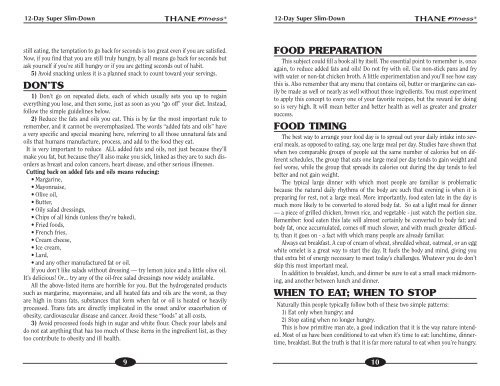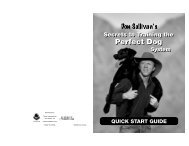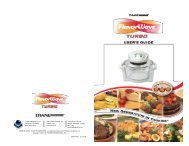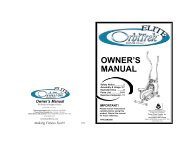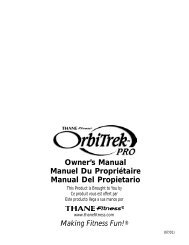12 Day Slim Down Guide in - Thane
12 Day Slim Down Guide in - Thane
12 Day Slim Down Guide in - Thane
Create successful ePaper yourself
Turn your PDF publications into a flip-book with our unique Google optimized e-Paper software.
<strong>12</strong>-<strong>Day</strong> Super <strong>Slim</strong>-<strong>Down</strong><br />
<strong>12</strong>-<strong>Day</strong> Super <strong>Slim</strong>-<strong>Down</strong><br />
still eat<strong>in</strong>g, the temptation to go back for seconds is too great even if you are satisfied.<br />
Now, if you f<strong>in</strong>d that you are still truly hungry, by all means go back for seconds but<br />
ask yourself if you’re still hungry or if you are gett<strong>in</strong>g seconds out of habit.<br />
5) Avoid snack<strong>in</strong>g unless it is a planned snack to count toward your serv<strong>in</strong>gs.<br />
DON’TS<br />
1) Don’t go on repeated diets, each of which usually sets you up to rega<strong>in</strong><br />
everyth<strong>in</strong>g you lose, and then some, just as soon as you “go off” your diet. Instead,<br />
follow the simple guidel<strong>in</strong>es below.<br />
2) Reduce the fats and oils you eat. This is by far the most important rule to<br />
remember, and it cannot be overemphasized. The words “added fats and oils” have<br />
a very specific and special mean<strong>in</strong>g here, referr<strong>in</strong>g to all those unnatural fats and<br />
oils that humans manufacture, process, and add to the food they eat.<br />
It is very important to reduce ALL added fats and oils, not just because they’ll<br />
make you fat, but because they’ll also make you sick, l<strong>in</strong>ked as they are to such disorders<br />
as breast and colon cancers, heart disease, and other serious illnesses.<br />
Cutt<strong>in</strong>g back on added fats and oils means reduc<strong>in</strong>g:<br />
• Margar<strong>in</strong>e,<br />
• Mayonnaise,<br />
• Olive oil,<br />
• Butter,<br />
• Oily salad dress<strong>in</strong>gs,<br />
• Chips of all k<strong>in</strong>ds (unless they’re baked),<br />
• Fried foods,<br />
• French fries,<br />
• Cream cheese,<br />
• Ice cream,<br />
• Lard,<br />
• and any other manufactured fat or oil.<br />
If you don’t like salads without dress<strong>in</strong>g — try lemon juice and a little olive oil.<br />
It’s delicious! Or... try any of the oil-free salad dress<strong>in</strong>gs now widely available.<br />
All the above-listed items are horrible for you. But the hydrogenated products<br />
such as margar<strong>in</strong>e, mayonnaise, and all heated fats and oils are the worst, as they<br />
are high <strong>in</strong> trans fats, substances that form when fat or oil is heated or heavily<br />
processed. Trans fats are directly implicated <strong>in</strong> the onset and/or exacerbation of<br />
obesity, cardiovascular disease and cancer. Avoid these “foods” at all costs.<br />
3) Avoid processed foods high <strong>in</strong> sugar and white flour. Check your labels and<br />
do not eat anyth<strong>in</strong>g that has too much of these items <strong>in</strong> the <strong>in</strong>gredient list, as they<br />
too contribute to obesity and ill health.<br />
FOOD PREPARATION<br />
This subject could fill a book all by itself. The essential po<strong>in</strong>t to remember is, once<br />
aga<strong>in</strong>, to reduce added fats and oils! Do not fry with oil. Use non-stick pans and fry<br />
with water or non-fat chicken broth. A little experimentation and you’ll see how easy<br />
this is. Also remember that any menu that conta<strong>in</strong>s oil, butter or margar<strong>in</strong>e can easily<br />
be made as well or nearly as well without those <strong>in</strong>gredients. You must experiment<br />
to apply this concept to every one of your favorite recipes, but the reward for do<strong>in</strong>g<br />
so is very high. It will mean better and better health as well as greater and greater<br />
success.<br />
FOOD TIMING<br />
The best way to arrange your food day is to spread out your daily <strong>in</strong>take <strong>in</strong>to several<br />
meals, as opposed to eat<strong>in</strong>g, say, one large meal per day. Studies have shown that<br />
when two comparable groups of people eat the same number of calories but on different<br />
schedules, the group that eats one large meal per day tends to ga<strong>in</strong> weight and<br />
feel worse, while the group that spreads its calories out dur<strong>in</strong>g the day tends to feel<br />
better and not ga<strong>in</strong> weight.<br />
The typical large d<strong>in</strong>ner with which most people are familiar is problematic<br />
because the natural daily rhythms of the body are such that even<strong>in</strong>g is when it is<br />
prepar<strong>in</strong>g for rest, not a large meal. More importantly, food eaten late <strong>in</strong> the day is<br />
much more likely to be converted to stored body fat. So eat a light meal for d<strong>in</strong>ner<br />
— a piece of grilled chicken, brown rice, and vegetable - just watch the portion size.<br />
Remember: food eaten this late will almost certa<strong>in</strong>ly be converted to body fat; and<br />
body fat, once accumulated, comes off much slower, and with much greater difficulty,<br />
than it goes on - a fact with which many people are already familiar.<br />
Always eat breakfast. A cup of cream of wheat, shredded wheat, oatmeal, or an egg<br />
white omelet is a great way to start the day. It fuels the body and m<strong>in</strong>d, giv<strong>in</strong>g you<br />
that extra bit of energy necessary to meet today’s challenges. Whatever you do don’t<br />
skip this most important meal.<br />
In addition to breakfast, lunch, and d<strong>in</strong>ner be sure to eat a small snack midmorn<strong>in</strong>g,<br />
and another between lunch and d<strong>in</strong>ner.<br />
WHEN TO EAT; WHEN TO STOP<br />
Naturally th<strong>in</strong> people typically follow both of these two simple patterns:<br />
1) Eat only when hungry; and<br />
2) Stop eat<strong>in</strong>g when no longer hungry.<br />
This is how primitive man ate, a good <strong>in</strong>dication that it is the way nature <strong>in</strong>tended.<br />
Most of us have been conditioned to eat when it’s time to eat: lunchtime, d<strong>in</strong>nertime,<br />
breakfast. But the truth is that it is far more natural to eat when you’re hungry.<br />
9<br />
10


